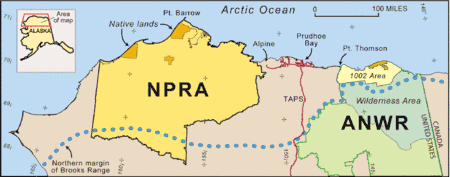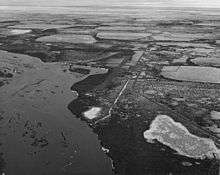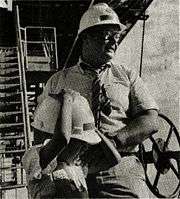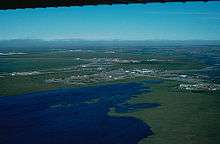Prudhoe Bay Oil Field
Prudhoe Bay Oil Field is a large oil field on Alaska's North Slope. It is the largest oil field in North America, covering 213,543 acres (86,418 ha) and originally containing approximately 25 billion barrels (4.0×109 m3) of oil.[1] The amount of recoverable oil in the field is more than double that of the next largest field in the United States by acreage (the East Texas oil field), while the largest by reserves is the Permian Basin (North America). The field was operated by BP; partners are ExxonMobil and ConocoPhillips Alaska until August of 2019; when BP sold all it's Alaska assets to Hilcorp.[2]
| Prudhoe Bay oil field | |
|---|---|
 | |
| Country | United States |
| Region | Alaska North Slope |
| Offshore/onshore | onshore |
| Coordinates | 70°18′24″N 148°43′57″W |
| Operator | BP |
| Partners | BP, ExxonMobil, ConocoPhillips Alaska |
| Field history | |
| Discovery | March 12, 1968 by ARCO and Exxon's Prudhoe Bay State #1 well |
| Start of production | June 20, 1977 |
| Peak of production | 1.5 million barrels per day (240,000 m3/d) |
| Peak year | 1988 |
| Production | |
| Current production of oil | 281,000 barrels per day (~1.40×107 t/a) |
| Year of current production of oil | 2015 |
| Estimated oil in place | 25,000 million barrels (~3.4×109 t) |
| Estimated gas in place | 46,500×109 cu ft (1,320×109 m3) |
| Producing formations | Sadlerochit |
Location
The field is located 400 miles (640 km) north of Fairbanks and 650 miles (1,050 km) north of Anchorage, 250 miles (400 km) north of the Arctic Circle, and 1,200 miles (1,900 km) south of the North Pole.[1] It is on the North Slope and lies between the National Petroleum Reserve–Alaska to the west and the Arctic National Wildlife Refuge to the east.
Leasing
The State of Alaska owns the land and leases the area as the Prudhoe Bay Unit.[3] In the terminology that the State of Alaska uses in its leasing program, the "Prudhoe Bay Oil Field" is called the Prudhoe Bay Oil Pool.[4] Oil pools within the Prudhoe Bay Unit include the following - maps showing the location of each pool are in the associated reference.
| Pool name | Operator | Discovery well driller | Discovery well start date |
|---|---|---|---|
| Aurora[5] | BP Exploration | Mobil | August 24, 1969 |
| Borealis Pool[6] | BP Exploration | Mobil | August 8, 1969 |
| Lisburne[7] | BP Exploration | Arco | December 16, 1967 |
| Midnight Sun[8] | BP Exploration | BP Exploration | December 20, 1997 |
| Russell Drilling Undef[9] | BP Exploration | BP Exploration | March 10, 2001 |
| Niakuk[10] | BP Exploration | Sohio | April 18, 1985 |
| N Prudhoe Bay[11] | BP Exploration | Arco | April 4, 1970 |
| Orion[12] | BP Exploration | Mobil | April 7, 1969 |
| Polaris[13] | BP Exploration | BP Exploration | August 24, 1969 |
| Pt. McIntyre[14] | BP Exploration | Arco / Exxon | March 22, 1988 |
| Prudhoe[4] | BP Exploration | Arco | December 19, 1967 |
| PM Stump Island[15] | BP Exploration | Arco / Exxon | March 22, 1988 |
| PM Undefined[16] | BP Exploration | BP Exploration | January 25, 1997 |
| Ugnu Undefined WTRSP[17] | BP Exploration | BP Exploration | May 20, 2004 |
| West Beach[18] | BP Exploration | Arco | July 26, 1976 |
| W Beach Tertiary Undef WTR Pool[19] | BP Exploration | Arco / Exxon | July 22, 1976 |

History
Prudhoe Bay Oil Field Discovery Well Site | |
Alaska Heritage Resources Survey
| |
 | |
| Location | About 1.5 miles (2.4 km) northwest of Putuligayuk River mouth, along western shore of Prudhoe Bay |
|---|---|
| Nearest city | Prudhoe Bay |
| Coordinates | 70°19′27″N 148°32′28″W |
| Area | less than one acre |
| Built | 1967 |
| Built by | Atlantic Richfield Corporation; Humble Oil Company |
| NRHP reference No. | 00000264[20] |
| AHRS No. | XBP-00056 |
| Added to NRHP | March 23, 2000 |



The area was originally identified as a potential oil field and selected in the early 1960s as part of the 100 million acres the federal government allotted to the new state of Alaska under the Alaska Statehood Act as a form of economic support. Tom Marshall, a key state employee tasked with selecting the 100 million acres, said the geology reminded him of big oil basins he'd seen in Wyoming.[21][22] Commercial oil exploration started in Prudhoe Bay area in the 1960s and, after a number of fruitless years, a rig produced a natural gas flare in December 1967. The oil field was confirmed on March 12, 1968, by Humble Oil (which later became part of Exxon) and Atlantic Richfield Company (ARCO), with the well Prudhoe Bay State #1.[1][4][23] ARCO was the operating partner.[24] Drilling sites for the discovery and confirmation wells were staked by geologist Marvin Mangus. BP was among the companies that had been active in the region, and BP was able to establish itself as a major player in the western part of the Prudhoe field.[1] The field was initially operated as two separate developments, the BP Western Operating Area and the ARCO Eastern Operating Area. Upon acquisition of ARCO by BP and sale of ARCO Alaska assets to Phillips Petroleum in 2000, the two operating areas were consolidated and BP became the sole operator of the field.[1][25]:slide 4 In 1974 the State of Alaska's Division of Geological & Geophysical Surveys estimated that the field held 10 billion barrels (1.6×109 m3) of oil and 26 trillion cubic feet (740×109 m3) of natural gas.[26] Production did not begin until June 20, 1977 when the Alaska Pipeline was completed.[1]
The site of the field's discovery was listed on the National Register of Historic Places in 2000, and has a commemorative marker. A well was operated at that site until 1985.[27]
Operations
The field was initially operated as two separate developments, the BP Western Operating Area (WOA: Oil Rim) and the ARCO Eastern Operating Area (EOA: Gas Cap). Upon acquisition of ARCO by BP and sale of ARCO Alaska assets to Phillips Petroleum in 2000, the two operating areas were consolidated and BP became the sole operator of the field.[25]:slide 4
In the field, oil is moved through pipelines from about 1000 wells to a pumping station at the head of the Trans-Alaska Pipeline; "flow lines" carry oil from the wells to local processing centers, then through "transit lines" to the pumping station.[25]:slides 4a-d According to a 2007 recording of BP representative, to replace the "huge volume of material" BP removes from beneath the ground, sea water is injected that is collected from Prudhoe Bay, Alaska.[28]
Production
North Slope oil production peaked in 1989 at 2 million barrels per day (320×103 m3/d) (Greater Prudhoe Bay: 1.5 million barrels per day (240×103 m3/d), but had fallen to 943,000 barrels per day (149,900 m3/d) in 2005,[29] while Greater Prudhoe averaged 411,000 barrels per day (65,300 m3/d) in December, 2006 and Prudhoe itself averaged 285,000 barrels per day (45,300 m3/d).[30] Total production from 1977 through 2005 was 11 billion barrels (1.7×109 m3).
As of August 2006, BP estimated that 2 billion barrels (320×106 m3) of recoverable oil remain and can be recovered with current technology.[1][31]
Associated oil fields

The Milne Point oil field is 35 miles (56 km) west of Prudhoe Bay and the leased area, called the Milne Point Unit by the State of Alaska, includes the Kuparuk River Oil Pool,[32] Sag River Oil Pool,[33] and the Schrader Bluff Oil Pool.[34]
The source rock for the Prudhoe Bay Oil Field and neighboring reserves is a potential source for tight oil and shale gas. As of 2013 mineral rights to 500,000 acres overlying the North Slope oil shale had been leased by Great Bear Petroleum whose principal is the petroleum geologist Ed Duncan.[35]
Geology

The field is an anticline structure located on the Barrow Arch, with faulting on the north side of the arch and a Lower Cretaceous unconformity on the east.[36]
Claims on petroleum seeps in the Cape Simpson area were first made in 1915 by a group consisting of T.L. Richardson, W.B. Van Valen, O. Hansen, B. Panigeo and Egowa after these last two, Eskimos, pointed out two large mounds fifty feet high and 200 feet in diameter.[37] Gold prospectors Smith and Berry also discovered these seeps and formed an investment group in San Francisco led by R.D. Adams, who funded an investigation led by the geologist H.A. Campbell.[38] His report noted disputing claims by Standard Oil Company.[39] This led to the establishment of the Naval Petroleum Reserve No. 4 in 1923, after which the Navy engaged the United States Geological Survey to survey the area from 1923 until 1926, who concluded the best objectives were Cretaceous rocks.[40] From 1943 until 1953, the Navy drilled eighty wells, including the area at Cape Simpson and Umiat but none flowed more than 250 barrels per day.[41]
The discovery of the Swanson River Oil Field on the Kenai Peninsula in 1957 by the Richfield Oil Corporation prompted the company to send geologists to the Arctic starting in 1959 and seismic survey crews in 1963, which recorded a reconnaissance line across what was identified as the Prudhoe structure in 1964.[42] In 1965, during the state lease sale, Richfield partnered with Humble Oil and acquired leases over what was later identified as the gas cap while British Petroleum was awarded leases over the "oil ring".[43]
In 1968, Prudhoe Bay State No. 1 encountered the Permian-Triassic Sadlerochit formation at 8200 feet which flowed gas at 1.25 million cubic feet per day with 20-27 per cent porosity and "tens of millidarcies" permeability.[44] Oil, condensate and gas are produced from the Triassic, Ivishak sandstone. This reservoir was deposited as a complex amalgamation of fan deltas and alluvial fans. The continuity of this fan delta was shown to extend seven miles away when the ARCO-Humble Sag River State No. 1 well was drilled.[45] During the field's early life the oil-bearing sandstone in some locations was 600 feet (180 m) thick. Today, the oil bearing zone's average thickness is about 60 feet (18 m) and the initial estimate of Oil in place was 2.3 billion barrels.[46][47]
The original target of the Prudhoe Bay State No. 1 was the Mississippian Lisburne limestone, encountered at 8,800 feet and flowed 1,152 barrels of oil per day in the 9,505 to 9,825 foot interval along with 1.3 million cubic feet of gas.[48] This initial oil was burned "because there wasn't ample storage", the flames of which were spotted by a passing airline.[49] The Department of Energy in 1991 estimated oil in place for this formation at 3.1 billion barrels.[50]
Statistics
Statistics for the Greater Prudhoe Bay Field:[1]
- Discovery well: Prudhoe Bay State #1
- Discovery date: December 26, 1967[51]
- Step-out well March 1968 confirmed[51]
- Production start: June 20, 1977
- Total field area: 213,543 acres (864.18 km2)
- Oil production wells: 1114
- Total capacity: 25 billion barrels (4.0×109 m3)
- Produced: 12 billion barrels (1.9×109 m3) as of March 28, 2013
- Total recoverable: 16 billion barrels (2.5×109 m3)
- Remaining recoverable: 4 billion barrels (640,000,000 m3)
- Peak production: 1.7 million barrels per day (270,000 m3/d) (1979)
- Natural gas:
- Total: 46×1012 cu ft (1,300 km3) (estimated)
- Recoverable: 26×1012 cu ft (740 km3)
- Greater Prudhoe Bay satellite fields:
- East Operating Area (formerly ARCO)(production start date: 1977)
- West Operating Area (BP Exploration)(production start date: 1977)
- Midnight Sun (production start date: 1998)
- Aurora (production start date: 2000)
- Orion (production start date: 2002)
- Polaris (production start date: 1999)
- Borealis (production start date: 2001)
- Ownership:
- BP Exploration (Operator): 26%
- ConocoPhillips Alaska Inc.: 36%
- ExxonMobil: 36%
- Others: 2%
- On 27 August 2019 BP announces the agreement to sell all its Alaska operations and interests to Hilcorp for $5.6 billion. The transaction includes interests in giant Prudhoe Bay field and Trans Alaska Pipeline.[52]
March 2006 oil spill
On March 2, 2006, a worker for BP Exploration (Alaska) discovered an oil spill in western Prudhoe Bay. Up to 6,400 barrels (1,020 m3) were spilled, making it the largest oil spill on Alaska's north slope to date.[53] The spill was attributed to a pipeline rupture.
In October 2007, BP was found guilty to a misdemeanor violation of the Clean Water Act to resolve criminal liability relating to pipeline leaks of crude oil. As a result of the guilty plea, BP Alaska agreed to pay $20 million which included the criminal fine, community service payments and criminal restitution.[54]
August 2006 shutdown
The March 2006 oil spill led the United States Department of Transportation to mandate that the transit lines be inspected for corrosion. As a result, BP announced on 6 August 2006 they had discovered severe corrosion, with losses of 70 to 81 percent in the 3/8-inch thickness of the pipe walls. Oil leaking was reported in one area, with the equivalent of four to five barrels of oil spilled.[55] The damage required replacement of 16 of 22 miles (35 km) of pipeline at the Prudhoe Bay. BP said it was surprised to find such severe corrosion and that it had been 14 years since they had used a pipeline inspection gauge ("pig") to clean out its lines because the company believed the use of the pigging equipment might damage pipe integrity.[56] BP Exploration announced that they were shutting down the oil field indefinitely, due to the severe corrosion and a minor leak in the oil transit lines.[56][57] This led to an 8% reduction in the amount of oil produced by the United States, as Prudhoe Bay was the country's largest oil producer, producing over 400,000 barrels per day (64,000 m3/d).
BP initially estimated up to 2 to 3 months before the pipelines would be fully operational.[56] This caused increases in world oil prices,[58] and BP revised the estimated operational date to January 2007.[59] London brent crude hit an intra-day high of $77.73/barrel, the all-time high, at that time, being $78.18/barrel. United States crude oil peaked at $76.67/barrel. The state of Alaska, which gets most of its revenue from taxing the oil industry, lost as much as $6.4 million each day until production restarted.[60]
No part of the Alaska Pipeline was affected, although Alyeska said that lower crude oil volumes could slow pumping during the BP shutdown.[61]
The field has since reopened. In mid-June 2007, however, a small leak occurred in one of the pipelines that connect the field to the Trans-Alaska Pipeline, shutting down the field for a week.[62]
In March 2009 the State of Alaska sued BP in matter number 3AN-09-06181-CI alleging that BP was negligent in its management of rigging operations and corrosion control in the transit lines leading from the field into pumping station one of the Trans Alaska Pipeline. The state is seeking damages for lost royalty and tax revenues. The case seems to have been dismissed in 2010.[63]
See also
References
- Prudhoe Bay Fact Sheet Archived 2009-03-26 at the Wayback Machine. BP. August 2006. (Adobe Acrobat *.PDF document)
- https://www.cnbc.com/2019/08/27/bp-sells-alaska-assets-to-hilcorp-alaska-for-5point6-billion.html
- Staff, Alaska Oil and Gas Conservation Commission. Oil and Gas Pools - Statistics Pages Archived 2012-12-30 at the Wayback Machine Accessed April 14, 2013
- Staff, Alaska Oil and Gas Conservation Commission. AOGCC Pool Statistics, Prudhoe Bay Unit, Prudhoe Oil Pool Archived 2013-12-30 at the Wayback Machine
- Staff, Alaska Oil and Gas Conservation Commission. AOGCC Pool Statistics, Prudhoe Bay Unit, Aurora Oil Pool Archived 2013-12-30 at the Wayback Machine
- Staff, Alaska Oil and Gas Conservation Commission. AOGCC Pool Statistics, Prudhoe Bay Unit, Borealis Oil Pool Archived 2013-12-30 at the Wayback Machine
- Staff, Alaska Oil and Gas Conservation Commission. AOGCC Pool Statistics, Prudhoe Bay Unit, Lisburne Oil Pool Archived 2013-12-30 at the Wayback Machine
- Staff, Alaska Oil and Gas Conservation Commission. AOGCC Pool Statistics, Prudhoe Bay Unit, Midnight Sun Oil Pool Archived 2012-12-30 at the Wayback Machine
- Staff, Alaska Oil and Gas Conservation Commission. AOGCC Pool Statistics, Prudhoe Bay Unit, Niakuk Ivsh-SR Undef Oil Pool Archived 2013-06-30 at the Wayback Machine
- Staff, Alaska Oil and Gas Conservation Commission. AOGCC Pool Statistics, Prudhoe Bay Unit, Niakuk Oil Pool Archived 2013-12-30 at the Wayback Machine
- Staff, Alaska Oil and Gas Conservation Commission. AOGCC Pool Statistics, Prudhoe Bay Unit, N Prudhoe Bay Oil Pool Archived 2013-06-30 at the Wayback Machine
- Staff, Alaska Oil and Gas Conservation Commission. AOGCC Pool Statistics, Prudhoe Bay Unit, Orion Oil Pool Archived 2013-12-30 at the Wayback Machine
- Staff, Alaska Oil and Gas Conservation Commission. AOGCC Pool Statistics, Prudhoe Bay Unit, Polaris Oil Pool Archived 2013-12-30 at the Wayback Machine
- Staff, Alaska Oil and Gas Conservation Commission. AOGCC Pool Statistics, Prudhoe Bay Unit, Pt. McIntyre Oil Pool Archived 2013-12-30 at the Wayback Machine
- Staff, Alaska Oil and Gas Conservation Commission. AOGCC Pool Statistics, Prudhoe Bay Unit, PM Stump Island Archived 2013-06-30 at the Wayback Machine
- Staff, Alaska Oil and Gas Conservation Commission. AOGCC Pool Statistics, Prudhoe Bay Unit, PM Undefined Archived 2013-06-30 at the Wayback Machine
- Staff, Alaska Oil and Gas Conservation Commission. AOGCC Pool Statistics, Prudhoe Bay Unit, Ugnu Undefined WTRSP Archived 2013-06-30 at the Wayback Machine
- Staff, Alaska Oil and Gas Conservation Commission. Pool Statistics, Prudhoe Bay Unit, West Beach Oil Pool Archived 2013-06-30 at the Wayback Machine
- Staff, Alaska Oil and Gas Conservation Commission. Pool Statistics, Prudhoe Bay Unit, W Beach Tertiary Undef WTR Pooll Archived 2013-06-30 at the Wayback Machine
- "National Register Information System". National Register of Historic Places. National Park Service. July 9, 2010.
- Harball, Elizabeth (2017-06-24). "Alaska's 40 Years Of Oil Riches Almost Never Was". NPR. Retrieved 27 June 2017.
- Ragsdale, Rose (2008-11-16). "40 Years at Prudhoe Bay: Young geologist changed Alaska history". Vol. 13, No. 46: Petroleum News. Retrieved 27 June 2017.CS1 maint: location (link)
- Arthur C. Banet, Jr. U.S Department of the Interior, Bureau of Land Management Alaska State Office. March 1991. Oil and Gas Development on Alaska's North Slope: Past Results and Future Prospects. Archived 2015-09-23 at the Wayback Machine BLM-Alaska Open File Report 31.
- Steve Quinn for Petroleum News. Vol. 16, No. 14 Week of April 03, 2011 ExxonMobil in Alaska: Exxon selects Prudhoe discovery well site: Humble Oil assumed an unusually active role as Atlantic Richfield’s 50-50 partner on Alaska’s North Slope in the 1960s
- International Mapping on behalf of BP. BP in Alaska, animated map Archived 2013-05-15 at the Wayback Machine
- Estimated Speculative Recoverable Resources of Oil and Natural Gas in Alaska. Division of Geological & Geophysical Surveys. Department of Natural Resources. State of Alaska. January 1974. (Adobe Acrobat *.PDF document)
- "NRHP nomination for Prudhoe Bay Oil Field Discovery Well Site". National Park Service. Retrieved 2015-03-25.
- "BP Seawater Treatment Plant in Prudhoe Bay, Alaska". Youtube. ATEECEICC. Retrieved 25 May 2015.
- "US Republicans set to turn Alaska's Arctic National Wildlife Refuge into oilfield". Bellona.com. 14 April 2005. Archived from the original on 26 November 2005. Retrieved 2006-08-08.
- "Alaska North Slope production breaks 800,000 bbl/d (130,000 m3/d) barrier". Petroleum News. 7 January 2007.
- BP Plans to Pull Another 2B Barrels of Oil from Alaska's Prudhoe Bay. Rigzone. February 22, 2008
- Staff, Alaska Oil and Gas Conservation Commission. AOGCC Pool Statistics, Milne Point Unit, Kuparuk River Oil Pool Archived 2013-05-30 at the Wayback Machine
- Staff, Alaska Oil and Gas Conservation Commission. AOGCC Pool Statistics, Milne Point Unit, Sag River Oil Pool Archived 2012-12-30 at the Wayback Machine
- Staff, Alaska Oil and Gas Conservation Commission. AOGCC Pool Statistics, Milne Point Unit, Schrader Bluff Oil Pool Archived 2013-12-30 at the Wayback Machine
- Margaret Kriz Hobson (April 3, 2013). "SHALE OIL: Geologist's Alaska gamble could turn into America's next big shale play". Energy Wire, E & E Publishing. Retrieved April 4, 2013.
- Sweet, J.M., 2008, Discovery at Prudhoe Bay Oil, Blaine: Hancock House, ISBN 978-0-88839-630-3, p. 183
- Sweet, J.M., 2008, Discovery at Prudhoe Bay Oil, Blaine: Hancock House, ISBN 978-0-88839-630-3, p. 63
- Sweet, J.M., 2008, Discovery at Prudhoe Bay Oil, Blaine: Hancock House, ISBN 978-0-88839-630-3, pp. 64-65
- Sweet, J.M., 2008, Discovery at Prudhoe Bay Oil, Blaine: Hancock House, ISBN 978-0-88839-630-3, p. 65
- Sweet, J.M., 2008, Discovery at Prudhoe Bay Oil, Blaine: Hancock House, ISBN 978-0-88839-630-3, pp. 68 and 86
- Sweet, J.M., 2008, Discovery at Prudhoe Bay Oil, Blaine: Hancock House, ISBN 978-0-88839-630-3, pp. 94-95
- Sweet, J.M., 2008, Discovery at Prudhoe Bay Oil, Blaine: Hancock House, ISBN 978-0-88839-630-3, pp. 111, 129 and 133
- Sweet, J.M., 2008, Discovery at Prudhoe Bay Oil, Blaine: Hancock House, ISBN 978-0-88839-630-3, p. 170
- Sweet, J.M., 2008, Discovery at Prudhoe Bay Oil, Blaine: Hancock House, ISBN 978-0-88839-630-3, pp. 238-239 and 242
- Sweet, J.M., 2008, Discovery at Prudhoe Bay Oil, Blaine: Hancock House, ISBN 978-0-88839-630-3, p. 242
- Sweet, J.M., 2008, Discovery at Prudhoe Bay Oil, Blaine: Hancock House, ISBN 978-0-88839-630-3, p. 245
- Jones, H.P.; Speers, R.G. (1976). Braunstein, Jules (ed.). Permo-Triassic Reservoirs of Prudhoe Bay Field, North Slope, Alaska, in North American Oil and Gas Fields. Tulsa: The American Association of Petroleum Geologists. pp. 23–50. ISBN 0891813004.
- Sweet, J.M., 2008, Discovery at Prudhoe Bay Oil, Blaine: Hancock House, ISBN 978-0-88839-630-3, pp. 248 and 254
- Sweet, J.M., 2008, Discovery at Prudhoe Bay Oil, Blaine: Hancock House, ISBN 978-0-88839-630-3, pp. 254 and 257
- Sweet, J.M., 2008, Discovery at Prudhoe Bay Oil, Blaine: Hancock House, ISBN 978-0-88839-630-3, p. 259
- "The Prize" Daniel Yergin
- "BP to quit Alaska after 60 years with $5.6 billion sale to Hilcorp", Reuters, 27 August 2019. Retrieved 27 August 2019.
- "Alaska hit by 'massive' oil spill". BBC News. March 11, 2006. Retrieved August 8, 2006.
- Chittim, Gary (November 3, 2008). "Agencies respond to oil spill whistle blower". KING 5.com. Archived from the original on November 7, 2008.
- "Biggest Oil Field in U.S. Is Forced to Stop Pumping". New York Times. 2006-08-08.
- Pemberton, Mary (8 August 2006). "Gas prices climb as oil pipeline in Alaska must be replaced". The Daily Texan. Retrieved 2006-08-08.
- "BP shutting top US oil field Prudhoe Bay due to spill". Reuters. 7 August 2006. Archived from the original on 8 January 2007. Retrieved 2006-08-08.
- Raft, Anna (7 August 2006). "BP restart of Prudhoe Bay oil field may take months". MarketWatch. Retrieved 2006-08-08.
- "BP oil field 'closed until 2007'". CNN. August 8, 2006. Archived from the original on February 10, 2008. Retrieved 2006-08-08.
- Loy, Wesley (7 August 2006). "BP shuts down Prudhoe Bay". Anchorage Daily News. Archived from the original on 2006-08-19. Retrieved 2006-08-08.
- Loy, Wesley & Richard Richtmyer (August 8, 2006). "Massive repairs: BP admits corrosion control was inadequate, prepares to replace North Slope transit lines". Anchorage Daily News. Archived from the original on 2006-08-21. Retrieved 2006-08-08.
- "BP to reopen oil pipeline in Alaska". The Scotsman. June 25, 2007. Retrieved 2007-07-10.
- Bolado, Carolina. "Court Dismisses Alaska's Lost Taxes Claim Against BP". Law360. Retrieved 28 December 2014.
Further reading
- Jamison, H.C., Brockett, L.D., and McIntosh, R.A., 1980, Prudhoe Bay - A 10-Year Perspective, in Giant Oil and Gas Fields of the Decade: 1968-1978, AAPG Memoir 30, Tulsa: American Association of Petroleum Geologists, ISBN 0-89181-306-3.
- Sweet, John M. (2008). Discovery at Prudhoe Bay. Blaine: Hancock House. pp. 312 pp. ISBN 978-0-88839-630-3.
External links
- Oil and Gas Resources of the Arctic Alaska Petroleum Province
- NPRA
- Milne Point goes mainstream. Inc. oilfield (Alaska Business Monthly, April 1995.)
- Prudhoe Bay, Alaska Aerial photos from the Prudhoe Bay area, July 2010